Neuroscience for Kids
Heroin
HORSE - CRANK - JIVE - SMACK -JUNK - SHAG - DOPE
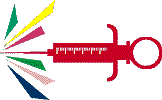 You can even spell it
by its chemical name: diacetylmorphine. It doesn't matter which way you
spell it, it still means HEROIN.
You can even spell it
by its chemical name: diacetylmorphine. It doesn't matter which way you
spell it, it still means HEROIN.
Heroin is an illegal opiate drug made from the opium poppy, Papaver somniferum. The opium poppy is a plant found in the Middle East, Southeast Asia and parts of Central and South America. To harvest opium, the seed pod of the poppy is cut and a juice flows out. The main ingredient that is extracted from raw opium is morphine. Morphine is easily converted to heroin by a chemical process.
 Opium Harvest |
 |
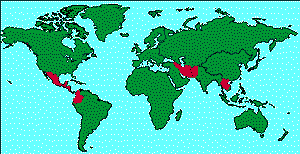 Places where opium is produced (shown in red) |
In 1973, scientists discovered that the brain had receptors for opiates. In other words, there are places on neurons that recognize opiates. These receptors were located in parts of the brain important for breathing, pain and emotions. The discovery of opiate receptors in the brain raised the question as to why neurons would have such receptors. Two years later, scientists found the answer: the brain manufactures its own opiates known as "endorphins." Endorphins are always in the brain, but they are released in greater amounts when people and animals are in pain or under stress.
History of the Opiates
 Records indicate that opium was used by the ancient
Egyptians, Greeks and Romans. The poppy even appears on Egyptian art
dating back 6,000 years. Opium was imported to China around 800 A.D. By
the 1600s, opium smoking was widespread throughout China. In 1680, a
famous English physician named Thomas Syndenham introduced opium to the
medical field.
Records indicate that opium was used by the ancient
Egyptians, Greeks and Romans. The poppy even appears on Egyptian art
dating back 6,000 years. Opium was imported to China around 800 A.D. By
the 1600s, opium smoking was widespread throughout China. In 1680, a
famous English physician named Thomas Syndenham introduced opium to the
medical field.
 In
the 17th century, many people in Europe were treated for a variety of
health problems with opium. In 1729, opium smoking was made illegal in
China and soon the importation of opium was banned. This ban upset the
British who were in charge of trading this valuable product. Opium was
still smuggled into China and this caused the "Opium
Wars" (1839-1842 and 1856-1860) between the British and the
Chinese.
In
the 17th century, many people in Europe were treated for a variety of
health problems with opium. In 1729, opium smoking was made illegal in
China and soon the importation of opium was banned. This ban upset the
British who were in charge of trading this valuable product. Opium was
still smuggled into China and this caused the "Opium
Wars" (1839-1842 and 1856-1860) between the British and the
Chinese.
 In the US, opium was
used to treat soldiers during the Civil War (1861-1865). During the late
1800s, doctors prescribed "tonics" containing opiates for many conditions.
Rarely did these medicines list opiates as one of the ingredients. In
fact, heroin was marketed as a cough medicine and a cure for morphine
addiction. However, many physicians had concerns about possible addiction
to these medicines.
In the US, opium was
used to treat soldiers during the Civil War (1861-1865). During the late
1800s, doctors prescribed "tonics" containing opiates for many conditions.
Rarely did these medicines list opiates as one of the ingredients. In
fact, heroin was marketed as a cough medicine and a cure for morphine
addiction. However, many physicians had concerns about possible addiction
to these medicines.
Important Dates in the History of Opiates
 1803 - morphine was isolated from opium by Frederick Serturner.
1803 - morphine was isolated from opium by Frederick Serturner.
1832 - codeine was extracted from opium.
1853 - the hypodermic needle was invented.
1874 - heroin was first produced from morphine.
1898 - The Bayer Company introduced heroin as a substitute for
morphine.
1906 - Pure Food and Drugs Act - required medicines to be labeled
with the materials that they contained.
1914 - Harrison Narcotic Act - added a tax on
opiate distribution.
1922 - Narcotic Import and Export Act - restricted
the importation of crude opium except for medical use.
1924 - Heroin Act - made manufacture and possession
of heroin illegal.
1930 - Federal Bureau of Narcotics was created.
1970 - Controlled
Substances Act was passed - divided drugs into categories, set
regulations and penalties for narcotics.
How Heroin is Used

 The purity of heroin can vary greatly. Heroin can be mixed with powdered
milk, sugar, baking soda, procaine and lidocaine (local anesthetics) or
even laundry detergent, talc, starch, curry powder, Ajax cleaner or
strychinine. All of these "additives" are dangerous if they are
injected into the bloodstream. Heroin is smoked or inhaled as a powder or
it can be mixed with water, heated, then injected. Heroin crosses through
the blood brain barrier 100 times faster than
morphine because it is highly soluble in lipids.
The purity of heroin can vary greatly. Heroin can be mixed with powdered
milk, sugar, baking soda, procaine and lidocaine (local anesthetics) or
even laundry detergent, talc, starch, curry powder, Ajax cleaner or
strychinine. All of these "additives" are dangerous if they are
injected into the bloodstream. Heroin is smoked or inhaled as a powder or
it can be mixed with water, heated, then injected. Heroin crosses through
the blood brain barrier 100 times faster than
morphine because it is highly soluble in lipids.
Injecting heroin into a vein (intravenous use) produces effects in 7 to 8 seconds. Injecting heroin into a muscle (intramuscular use) or under the skin (subcutaneous use) can produce effects in 5 to 8 minutes. Addicts sometimes inject themselves up to 4 times in one day.
Effects of Heroin
 The overall effect of heroin is a depression of the central nervous
system.
The overall effect of heroin is a depression of the central nervous
system.
Short Term Effects
- Analgesia (reduced pain)
- Brief euphoria (the "rush" or feeling of well-being)
- Nausea
- Sedation, drowsiness
- Reduced anxiety
- Hypothermia
- Reduced respiration; breathing difficulties
- Reduced coughing
- Death due to overdose - often the exact purity and content of the drug is not known to the user. An overdose can cause respiration problems and coma
Long Term Effects
 Tolerance: more and more drug is needed to produce the
euphoria and other effects on behavior.
Tolerance: more and more drug is needed to produce the
euphoria and other effects on behavior.
Addiction: psychological and physiological need for heroin. People are driven to get more heroin and feel bad if they do not get it. People begin to crave heroin 4 to 6 hours after their last injection.
Withdrawal: About 8-12 hours after their last heroin dose, addicts' eyes tear, they yawn and feel anxious and irritable. Excessive sweating, fever, stomach and muscle cramps, diarrhea and chills can follow several hours later. These withdrawal symptoms can continue for 1 to 3 days after the last dose and can last 7 to 10 days. In some cases, full recovery can take even longer.
Other Effects
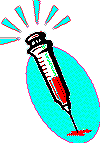 In addition to
the direct dangers of heroin, this powerful drug also carries the risk
of:
In addition to
the direct dangers of heroin, this powerful drug also carries the risk
of:
- HIV/AIDS - due to sharing of needles
- Poisoning - from the addition of toxin to the drug
- Hepatitis - liver damage
- Skin infections - from repeated intravenous injections
- Other bacterial and viral infections
- Increase risk of stroke
- Collapsed veins
- Lung infections
How Heroin Affects the Brain
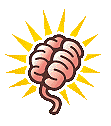
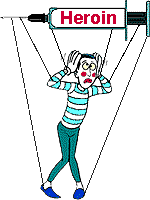 Not all of the mechanisms by which heroin and other opiates affect the
brain are known. Likewise, the exact brain mechanisms that cause
tolerance and addiction are not completely understood. Opiates stimulate a
"pleasure system" in the brain. This system involves neurons in the
midbrain that use the neurotransmitter called "dopamine." These midbrain
dopamine neurons project to another structure called the nucleus accumbens
which then projects to the cerebral cortex. This system is responsible
for the pleasurable effects of heroin and for the addictive power of the
drug. Other neurotransmitter systems, such as those
related to endorphins, are also likely to be involved
with withdrawal from and tolerance to heroin.
Not all of the mechanisms by which heroin and other opiates affect the
brain are known. Likewise, the exact brain mechanisms that cause
tolerance and addiction are not completely understood. Opiates stimulate a
"pleasure system" in the brain. This system involves neurons in the
midbrain that use the neurotransmitter called "dopamine." These midbrain
dopamine neurons project to another structure called the nucleus accumbens
which then projects to the cerebral cortex. This system is responsible
for the pleasurable effects of heroin and for the addictive power of the
drug. Other neurotransmitter systems, such as those
related to endorphins, are also likely to be involved
with withdrawal from and tolerance to heroin.
Treatment of Heroin Overdose and Addiction
Behavioral Methods: Heroin addiction is usually treated with both medical and behavioral methods. Behavioral treatment might give rewards to people for negative drug tests. Other treatments may attempt to change the drug-seeking behavior of addicts.
Naloxone: People who overdose on heroin are given a drug called "naloxone." Naloxone is an opiate receptor blocker that binds to neurons so opiates cannot work. Naltrexone is an opiate receptor blocker that is used to treat addiction to heroin.
Methadone: Methadone is a drug that blocks the effects of heroin and has been used for several decades to treat heroin addiction. Methadone can be swallowed (rather than injected) and it blocks heroin withdrawal symptoms and does not have euphoric or sedative effects.
LAAM: LAAM (levo-alpha-acetyl-methadol) is a drug like methadone, but its effects last longer. LAAM was approved by the US Food and Drug Administration for treating heroin addiction in 1993.
Buprenorphine: Buprenorphine is chemically similar to an opioid. However, it has less of a risk for an overdose than morphine, heroin or methadone and has milder withdrawal symptoms when its use is stopped. Buprenorphine was approved by the US Food and Drug Administration for treating opioid addiction in October, 2002.

Liquid Methadone
For more information about heroin, see:
- Addiction as a disease - PBS Close to Home
- Heroin in the Brain - from PBS Frontline
- Opium Throughout History - from PBS Frontline
- Methadone Maintenance
- Opiates - from the "Mind over Matter" series produced by the National Institute on Drug Abuse
- Opium Growing Maps and Trade Routes - PBS Frontline
- The Reconstructors - Play a problem-based adventure game to learn about drug abuse
- Buprenorphine
- The drug photographs used on this page are courtesy of the Indiana Prevention Resource Center
Other drugs:
| Alcohol | Amphetamines | Caffeine | Cocaine |
| Heroin | Inhalants | LSD | Marijuana |
| Nicotine | Ecstasy | Rohypnol | 1,4-Butanediol |
| GHB | Barbiturates | PCP | Hallucinogenic Mushrooms |
Copyright © 1996-2017, Eric H. Chudler All Rights Reserved.
